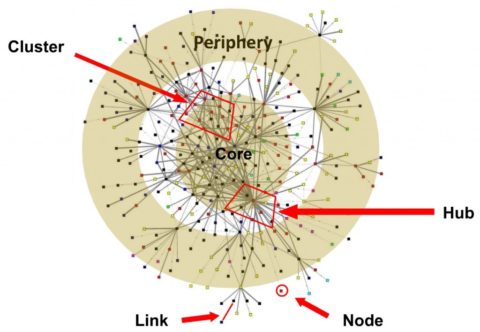Bringing a Network Theory Perspective to These Times, Part 1

“While a network, like a group, is a collection of people, it includes something more: a specific set of connections between people in the group. These ties, and the particular pattern of these ties, are often more important than the individual people themselves. They allow groups to do things that a disconnected collection of individuals cannot. The ties explain why the whole is greater than the sum of its parts. And the specific pattern of the ties is crucial to understanding how networks function.”
– Nicholas A. Christakis

At the Interaction Institute for Social Change, we have a collaborative change lens that includes the facets of (1) naming and building power and working for equity and inclusion; (2) seeing and advancing networks as the unit of action and analysis and (3) embracing love as a force for social transformation. With respect to networks, we have noticed that there are a lot of different takes on what networks are, why they matter, and how to “leverage” them for positive social change. Part of this may be due to the fact that network science and approaches span a variety of schools of thought and practice, including sociology, psychology, mathematics, political science, communication, anthropology, economics, and epidemiology.
I recently came across an article by Nancy Katz, David Lazer, Holly Arrow, and Noshir Contractor (2004) that names some of the commonalities that exist across these different schools and approaches that we’ve been experimenting with to advance social change networks, support resilience, and to shift patterns and flows in “systems as networks” to create regenerative communities and equitable wellbeing. The article, entitled “Network Theory and Small Groups,” refers to the work of Barry Wellman (1988), which lifts up five core principles of network theory that might provide some more coherence and alignment to “network approaches.”
- People’s behavior is best understood and predicted by the web of relationships in which they are embedded. These webs present opportunities and impose constraints on people’s behavior. So working with connections and flows can facilitate, inhibit and shape possibility.
- Nothing can be properly understood in isolation or in a segmented fashion. The focus of analysis should be the relationships between people or groups, rather than the units themselves or their intrinsic characteristics. So the quality of relationship matters and needs tending.
- Methods of “analysis” should not assume independence, but rather interdependence. People should be understood relationally. So think in terms of “collisions and ripples” as one network we are working with likes to say, characterizing network effects.
- The flow of information and resources between two people depends not simply on their relationship to each other but on their relationships to everybody else. Or in network science speak, “Understanding a social system requires more than merely aggregating the dyadic ties.” So focus not just on one-to-one exchanges, but one-to-many and many-to-many (scale-linking).
- Groups have fuzzy rather than firm boundaries. The building blocks of organizations and communities are not discrete groups but rather overlapping networks. Individuals generally have crosscutting relationships to a multitude of groups. So focus not simply on the impacts of bonding within groups but bridging across, and what this manifests.
Webs, relationships, flows, interdependence, intricacy, scale-linking, bonding and bridging. This is certainly not a full list of what network mindsets make visible to us, but hopefully lifts up some of what can help us better understand and work with reality, in these and at all times.